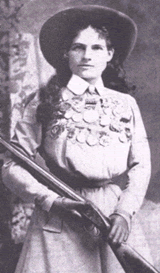When I was a girl, my grandfather took me to visit the grave of Annie Oakley. Annie had grown up in Darke County, Ohio, not far from the home of my ancestors and my grandfather remembered seeing her in Buffalo Bill’s Wild West Show. At the time, I had never heard of Annie Oakley, but I was enthralled by Granddad’s memories.
 Phoebe Ann Moses, born in 1860 to a Quaker farmer and his wife, learned to trap and shoot at an early age and following her father’s death helped support her mother and siblings, by selling game to local inns and taverns.
Phoebe Ann Moses, born in 1860 to a Quaker farmer and his wife, learned to trap and shoot at an early age and following her father’s death helped support her mother and siblings, by selling game to local inns and taverns.
In order to receive a premium for her game, Annie learned to shoot well enough to place a single shot in the head of her quarry. Neighbors said that she could shoot the head off of a quail before it had time to take wing. One of Annie’s clients was so impressed with her sharp shooting that he arranged a match between her and well-known marksman Frank Butler, who was on tour in Southern Ohio.
Butler was reported to have laughed, when he learned that a young woman was to be his local competition. But Annie, a slip of a girl, just five feet tall, won the match with 25 hits out of 25 shots and also claimed Butler’s heart. They were married on June 20, 1882 in a union last would last 44 years.
For several years after their marriage, Annie was Frank’s assistant in his traveling shooting act. But in 1885, they joined Buffalo Bill Cody’s Wild West Show and Frank relinquished the limelight to become Annie’s assistant and personal manager.
Dubbed “Little Sure Shot” by Chief Sitting Bull (of Battle of the Little Bighorn fame) who was one of Buffalo Bill’s headliners, Annie Oakley was the Wild West Show’s star attraction for 17 years. She captivated audiences at home and abroad with her stunning feats. In a celebrated tour of Europe, she entertained both Queen Victoria and Crown Prince Wilhelm of Germany.
In fact, Annie so impressed Wilhelm, when she shot a cigarette from the lips of Frank Butler, that the Crown Prince asked if he might hold one for her. Annie obliged, but put the cigarette in his hand instead of his mouth, which led some to later to speculate that if she had shot Wilhelm, instead of the cigarette, Annie might have prevented World War I.
Annie’s stunts were breathtaking. At 30 paces she could hit a playing card held edgewise; shoot a hole through coin; a cork out of a bottle; and snuff the flame from a candle. It was even said that she could “scramble” eggs in midair.
During her career, Annie established many records with a rifle, including one where she broke 4,772 tossed glass balls out of 5,000, in one day. She also held a record for shooting 96 small clay pigeons out of 100 and 49 live birds out of 50.
Following a train wreck in 1901, Annie suffered a spine injury that required five surgeries and left her temporarily paralyzed. Yet even in retirement, she continued to give performances and shooting lessons. She even proposed to recruit and train a regiment of women volunteers to fight in World War I, as well as to teach marksmanship to the troops – offers that were never accepted.
At the end of 1922, the Butlers were both injured in an auto accident. Annie’s injuries required that she wear a steel brace on her right leg, but she kept performing until 1925, when her health began to fail.
Annie was suffering from pernicious anemia caused by lead from the hundreds of thousands of bullets that she had handled during her career. The Butlers moved back to Darke County, OH in 1925 to be close to Annie’s family. Annie died there on November 3, 1926. Frank, who had stopped eating following Annie’s death, passed away on November 21, 1926.
Click here to watch a video clip of Annie Oakley in action.
